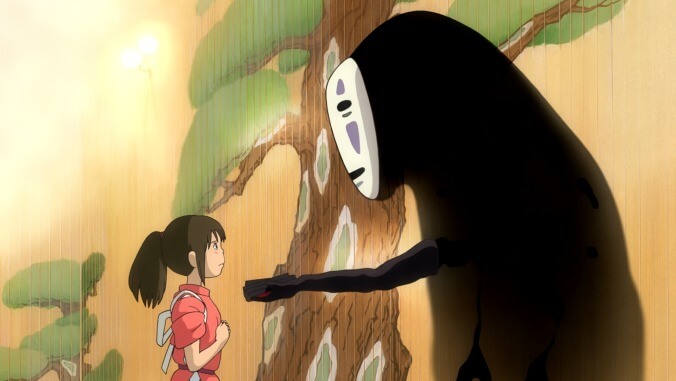Spirited Away at 20: How Hayao Miyazaki's masterpiece united animation lovers worldwide
And why todays uncertain landscape for animation makes the success and message of Miyazaki's opus even more profound two decades after the film's U.S. release

There’s a moment early on in Spirited Away that sticks with me after countless viewings and many years. Plucky ponytailed 10-year-old protagonist Chihiro breaks down by a river after losing her parents—and the human world she recognizes—in a bathhouse for the spirits. “It’s just a dream, a stupid dream,” Chihiro chides herself as she begins to cry. “Go away, disappear! Disappear!” When she looks down, she gasps in a moment of clarity her own ability to self-actualize: her fingertips begin dissolving into nothing.
“It plays into very strong fears that we all have of abandonment, of getting lost, of not knowing what we’re doing or what to do next,” Dr. Susan Napier, author of Miyazakiworld: A Life In Art and a professor at Tufts University, says of the film’s opening sequence. “I think it’s absolutely a global story.”
Spirited Away, which marked the 20th anniversary of its U.S. wide release on September 20, remains a touchstone in animated storytelling. The meticulous, dreamlike film saw a record-breaking 2001 premiere in Japan, but international appreciation for director Hayao Miyazaki made the already-ascendant director a star. Dr. Shiro Yoshioka, a professor at Newcastle University and one of the first doctoral candidates to complete a PhD on Miyazaki, describes Spirited Away (along with its predecessor, 1997’s gritty environmentalist film Princess Mononoke) as the “height” of Miyazaki’s career.
“He established his position as [Japan’s] filmmaker, as it were, and also a public intellectual,” Yoshioka explains. “The global success of the film added more significance to his status within Japan, further separating him and his films from other anime and their creators.”
Spirited to the states
The American appetite to consume and learn from Miyazaki’s luminous work is enormous–it’s also one that likely wouldn’t exist without Spirited Away’s mainstream U.S. rollout. It’s hard to overstate the role played by Disney-Pixar maven John Lasseter’s role in the film’s distribution and reception in the U.S. market. Lasseter first met Miyazaki in 1981, when Miyazaki was an animator with Tokyo’s TMS and Lasseter was an up-and-coming executive who was growing tired of Disney’s monotonous kid-friendliness. Miyazaki showed Lasseter’s team part of Miyazaki’s first feature, The Castle Of Cagliostro– Lasseter has said he was “blown away” by what he saw.
“It had a very strong effect on me because I felt that this was the first animated feature film I had seen that had a vision to entertain for all ages,” Lasseter said during a 2014 speech at the Tokyo Film Festival. “It made me feel that I was not alone in the world.”
Lasseter played a key role in bringing Spirited Away to a U.S. wide release in 2002 (Lasseter left Disney in 2018 amidst allegations of sexual misconduct.) At the time, Miyazaki was wary of foreign distribution for his films, after the U.S. release of Nausicaä: Valley Of The Wind saw the distributor cut 22 minutes from the original and advertised the film as Warriors Of The Wind. Following that snafu, Miyazaki’s producer sent then-Miramax head Harvey Weinstein (who handled Princess Mononoke’s release several years later) a katana alongside the words “no cuts.”
Acknowledging “blood, pain, dread, and death”
Although Miyazaki had gained recognition both in Japan and stateside with Princess Mononoke, Yoshioka explains that that film gained less traction due to an art-house heavy rollout. Spirited Away, with extra eyes trained on its wide release and a sweeping Oscars campaign, reached an international audience that was previously unprecedented for anime. Before Spirited Away, Miyazaki was a cult auteur with a dedicated Japanese fan base—afterwards, per Yoshioka, Miyazaki was elevated in the international ranks alongside older Japanese masters like Akira Kurosawa. Spirited Away was the first non-English language film to win Best Animated Feature, and remains the only hand-drawn film to do so. Miyazaki was awarded a Lifetime Achievement Oscar in 2014.
“Miyazaki’s luminescent, gorgeously realized world is relatively safe for children (good beats out evil and love conquers all, though it’s more important that honesty, courage, and personal integrity are always eventually rewarded), but it also acknowledges blood, pain, dread, and death in ways that other animated films wouldn’t dare,” Tasha Robinson wrote in her 2001 review of the film for The A.V. Club.